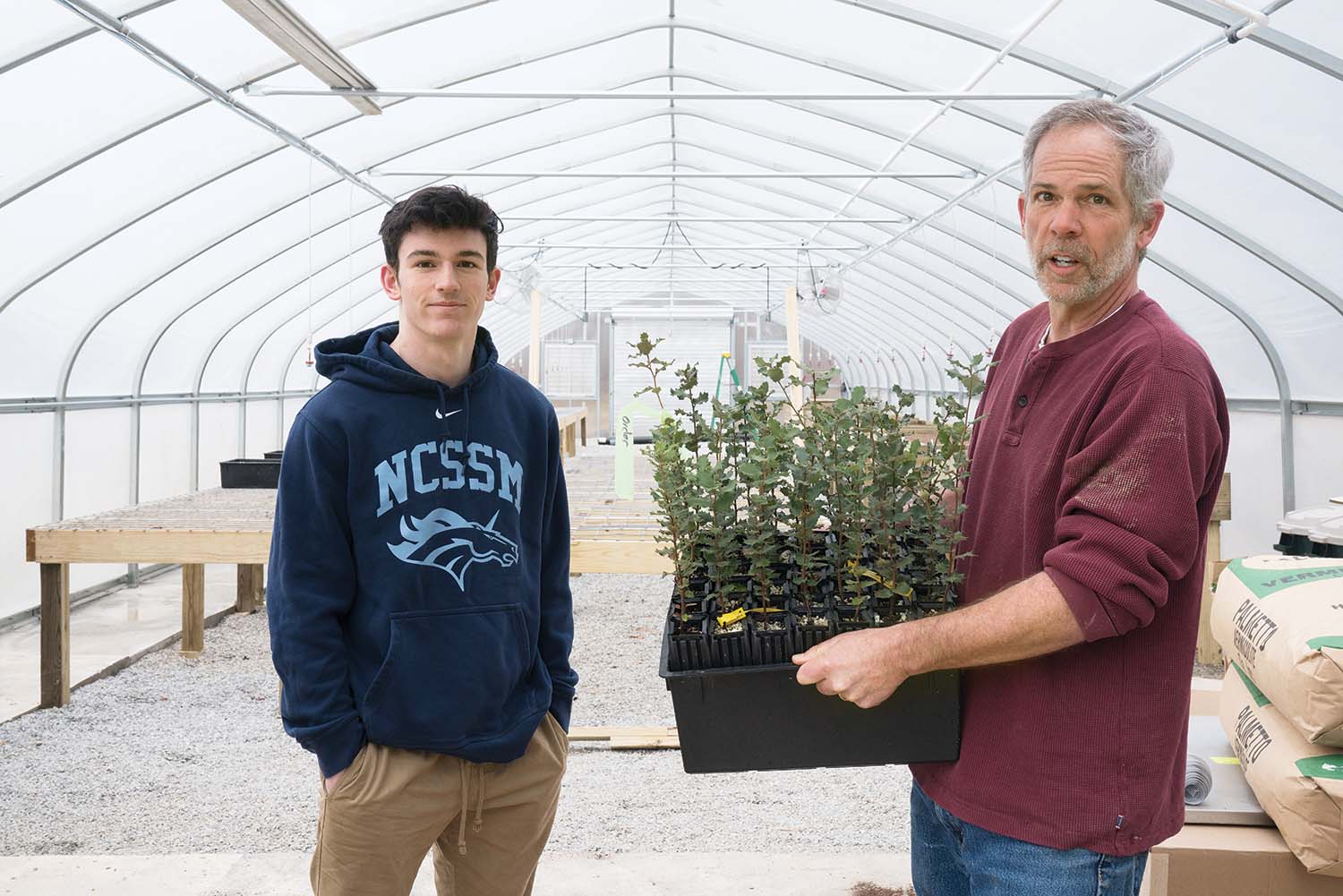
On his bucolic orchard in rural Fletcher, Brian Upchurch is about as far away from the Mafioso scene of New York City as one can get. But he has this in common with Michael Corleone, the ruthless don of The Godfather trilogy: just when he thought he was out of the family business, they pulled him back in.
In this case, the family business is horticulture, and “they” is his son Davis, a high-school student at the North Carolina School of Science and Mathematics in Durham. “I’d been growing ornamental plants for 25 years and sold my nursery when he came to me with the idea for a truffle orchard,” Brian explains. “I told him, ‘Davis, I’m tired of playing in dirt. I don’t want to do this anymore.’”
Brian and his wife Linda, who holds an MBA, challenged Davis — just 15 years old at the time — to develop a business plan for the venture. His proposal convinced the family to lay down the roots of Carolina Truffières, and the company now provides truffle-inoculated trees and orchard consulting to clients as far away as Idaho.
What attracted you to starting a truffle business?
Davis Upchurch: I first became interested in truffle cultivation because I noticed that it was a very environmentally and financially attractive example of alternative agriculture. When cultivating truffles, growers are not only improving their farms’ value, but they are also giving back to the environment through improving soil structure and reforestation.
What’s the biggest challenge to growing truffles in Western North Carolina?
Brian Upchurch: Black or Perigord truffles are a Mediterranean crop, and we aren’t located in a Mediterranean climate. We have the perfect temperature, but there’s a little too much rainfall. Also, while host trees and fungal mycelia will grow in our soil, the pH needs to be brought up to 7.5–8 before the truffles start fruiting.
Davis: Another key issue has been the Eastern filbert blight, a fungal disease impacting hazel hosts. Seedling providers failed to provide adequately resistant species, often referring to some selections of European hazels as immune rather than resistant. Many orchards could have been successful, but they had poor-quality, contaminated seedlings, and less than ideal host species.
Who are your biggest customers?
Davis: We generally cater to the product needs of established orchards by offering consulting, pest management and production advice, and certain products such as biostimulant. A major part of our business structure so far has been in correcting industry mistakes made when the necessary information was not yet common knowledge.
How has Carolina Truffières modernized its truffle production?
Davis: We measure essential values such as soil texture, rainfall, temperature range, and pH, researching the perfect conditions for the truffle and adapting the North Carolina environment if possible to fit these needs. Our production facility also has many biosecurity protocols in place to prevent any contaminants from affecting our seedlings.
Brian: Truffle fungi have male and female, as well as positive and negative types, similar to a male and female, and you need a balance to actually produce truffles. [For reasons yet to be understood, orchards usually shift to primarily female.] So we make and use a product called Spanish Wells to restore that equilibrium.
Many people associate truffles with specially trained pigs, but you recommend using dogs to find them instead. Why?
Brian: Pigs absolutely destroy a truffle orchard; they just root around until they find them. A dog can be trained to smell and go right to the truffles. The Lagotto, an Italian breed, is the go-to truffle dog, but any dog with the right temperament can be trained to hunt for them. We’re training a Goldendoodle now, and she’s immediately taken to it — she loves to sniff and wants to please.
Do you have a favorite way to use truffles in cuisine?
Davis: The best is incorporating truffles into sauces for meat dishes, such as a filet mignon with truffle butter or foie gras with black truffle. Truffles are also phenomenally good in desserts, such as vanilla-truffle ice cream.
Brian: I like them with rice dishes and with scrambled eggs, which is really easy to do. And you don’t have to have a beautiful truffle to do it!
What are your future plans for Carolina Truffières?
Brian: Right now, we’re in the waiting period before our own truffles are harvested. [This can take anywhere from 3-10 years.] But we see our orchard as eventually being the main breadwinner. In the meantime, we will continue to offer seedlings for orchard establishment. Almost all truffles consumed in the U.S. are imported, so we’re relatively local. Our price will be very competitive because they don’t have to be shipped from overseas, and they’ll be a fresher product. It’s just a matter of us getting our ducks in a row and producing.
Carolina Truffières, 269 Drake Farm Road, Fletcher. Brian and Davis will appear at the Mother Earth News Fair at the WNC Agricultural Center (1301 Fanning Bridge Road, in Fletcher) on Friday, April 28 and Sunday, April 29, motherearthnewsfair.com. For more information, call 828-301-0729 or see carolinatruffieres.com.
